

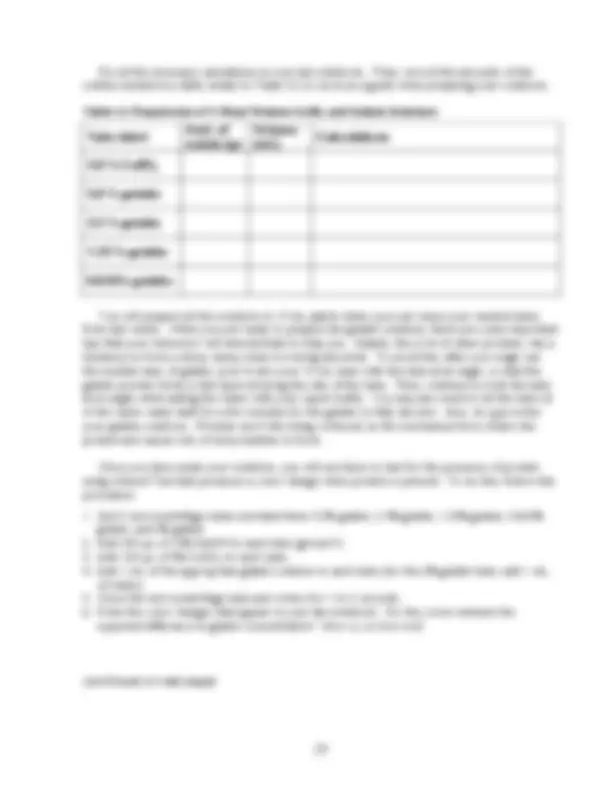
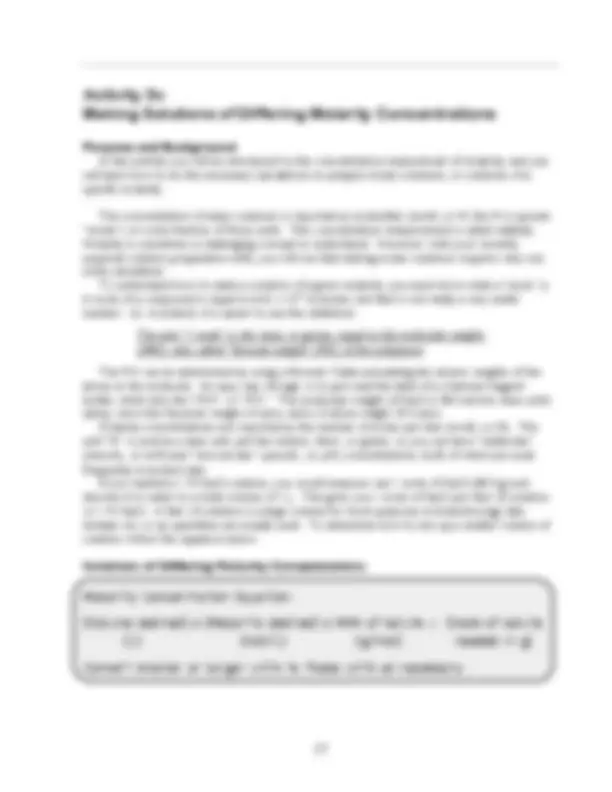
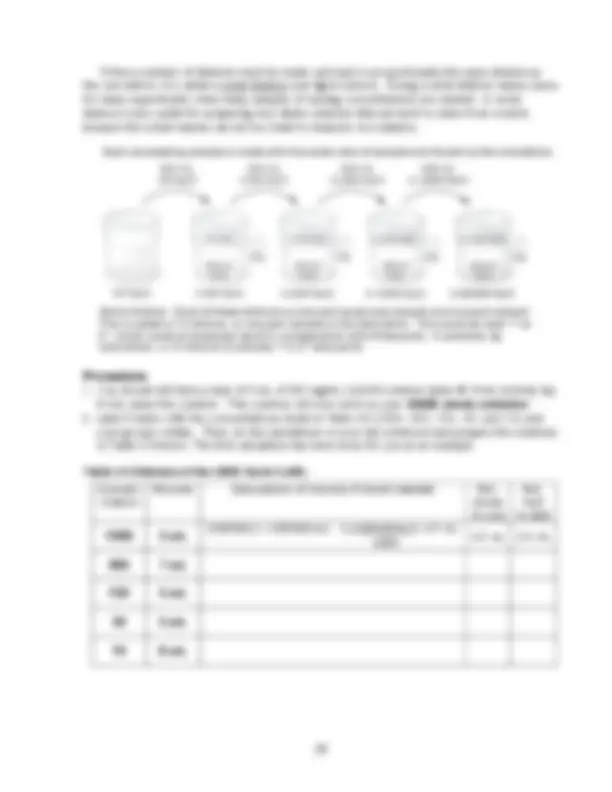
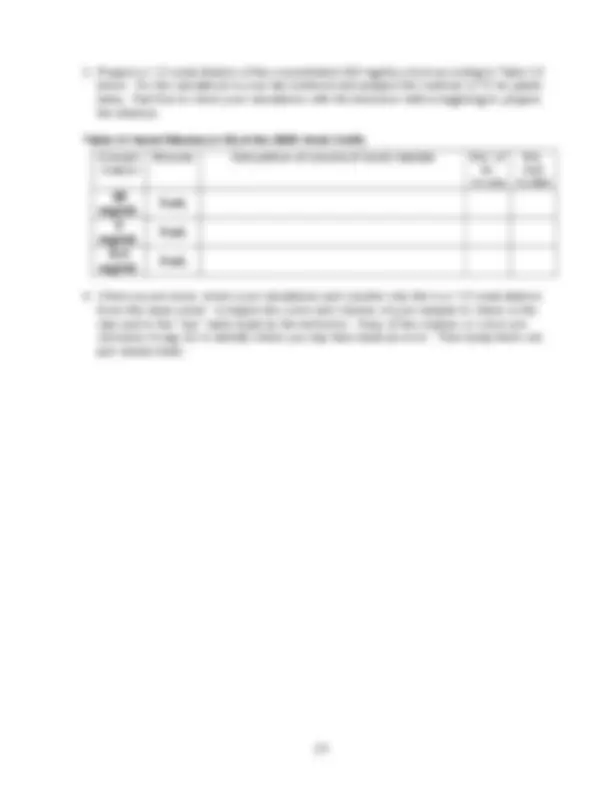
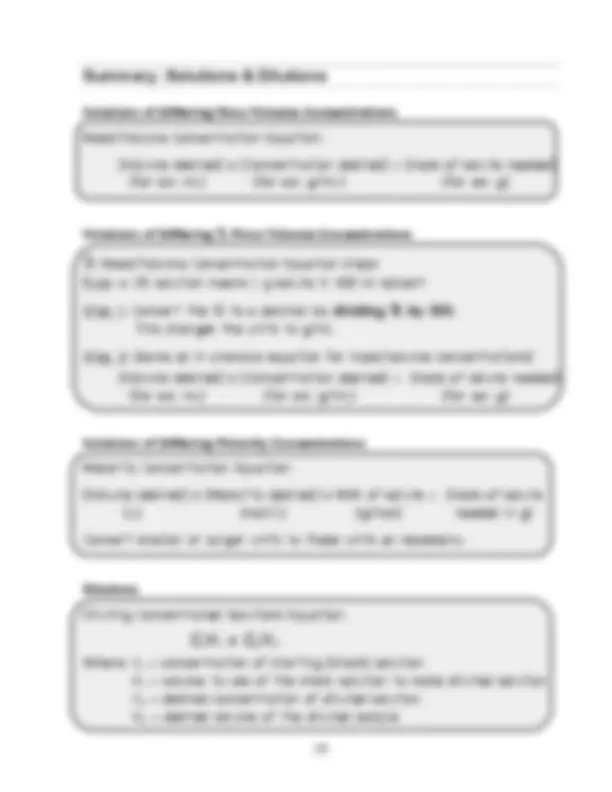
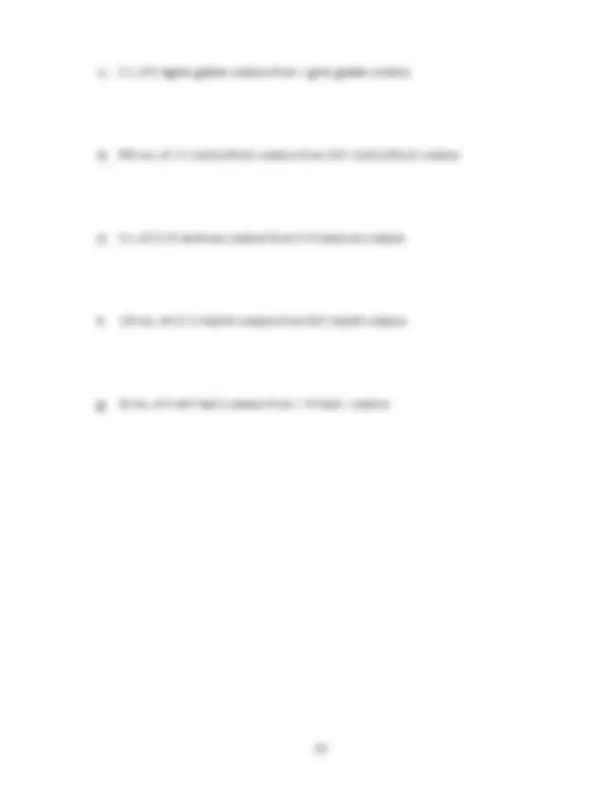


Study with the several resources on Docsity

Earn points by helping other students or get them with a premium plan


Prepare for your exams
Study with the several resources on Docsity

Earn points to download
Earn points by helping other students or get them with a premium plan
Community
Ask the community for help and clear up your study doubts
Discover the best universities in your country according to Docsity users
Free resources
Download our free guides on studying techniques, anxiety management strategies, and thesis advice from Docsity tutors
The molecular weight (MW) for CuSO4 (actually copper sulfate pentahydrate, or CuSO4•H2O) is 250 g/mol. The first calculation has been done for you as an example ...
Typology: Exercises
1 / 13

This page cannot be seen from the preview
Don't miss anything!








Making solutions is a very common activity for lab workers in a biotechnology lab. Proper solution making requires basic math skills, accurate measurement, and the ability to follow instructions. A solution is a homogeneous mixture of two or more substances. In a solution, the solute is the substance that is dissolved in the solvent. Most of the time, the solvent will be H 2 O, so if it is not otherwise specified, assume that you should dissolve the necessary amount of solute calculated in H 2 O.
Purpose and Background In this activity, you will learn how to calculate and make copper sulfate (CuSO 4 ) solutions of differing mass/volume concentrations. Solutions are prepared with a certain mass of solute in a certain volume of solvent, similar to the glucose solutions made in Activity 2c. Any metric mass in any metric volume is possible, but the most common units of mass/volume concentrations are as follows: g/mL grams per milliliter g/L grams per liter mg/mL milligrams per milliliter μg/mL micrograms per milliliter μg/μL micrograms per microliter ng/mL nanograms per milliliter ng/μL nanograms per microliter Although concentrations can be reported in any mass/volume units, these 7 mass/volume units are the most common in biotechnology applications. The prefix “nano-“ means one- billionth. A nanogram is equal to 0.001 μg, and there are 1000 ng in 1 μg. To determine how to prepare a certain volume of a solution at a certain mass volume concentration, use the equation that follows.
Note:
10 g of solute Add ~75% of solvent volume; mix to dissolve; add more solvent to reach final volume Example: You need to make 20 mL of a 40 mg/mL solution of glucose. How many grams of glucose will you need to measure to make this solution? (20 mL) (40 mg) = 800 mg but you want to know how many g, not mg, mL so convert 800 mg to grams (= 0.8 g) Notice how the mL units cancel out during multiplication so as to leave the answer in mg to be weighed out. Since the balances measure in grams, it was necessary to convert mg to g. To make this solution, 0.8 g of glucose is weighed and put into a graduated 50 mL tube. Approximately 15 mL (~75 % of final volume) of solvent (deionized water or buffer) is added to the tube, and the contents are mixed using the vortex. Then, additional solvent is added to reach a total volume of 20 mL. The reason that not all 20 mL of solvent is added initially is that the solute may take up some space when it dissolves in the solvent. Thus, if we had added all 20 mL to the solute at once, the final volume may have in fact been greater than 20 mL. Procedure
Do all the necessary calculations in your lab notebook. Then, record the amounts of the solutes needed in a table similar to Table 3.2 to serve as a guide when preparing your solutions. Table 3.2 Preparation of % Mass/Volume CuSO 4 and Gelatin Solutions Tube label Amt. of solute (g) Volume (mL) Calculations 5.0 % CuSO 4 5.0 % gelatin 2.5 % gelatin 1.25 % gelatin 0.625% gelatin You will prepare all the solutions in 15 mL plastic tubes (you can reuse your washed tubes from last week). When you are ready to prepare the gelatin solutions, there are some important tips that your instructor will demonstrate to help you. Gelatin, like a lot of other proteins, has a tendency to form a sticky clump when it is being dissolved. To avoid this, after you weigh out the needed mass of gelatin, pour it into your 15 mL tube with the tube at an angle, so that the gelatin powder forms a thin layer all along the side of the tube. Then, continue to hold the tube at an angle while adding the water with your squirt bottle. You may also need to let the tube sit in the warm water bath for a few minutes for the gelatin to fully dissolve. Also, do not vortex your gelatin solutions. Proteins don’t like being vortexed, as the mechanical force shears the protein and causes lots of sticky bubbles to form. Once you have made your solutions, you will use them to test for the presence of protein using a Biuret Test that produces a color change when protein is present. To do this, follow this procedure:
Purpose and Background In this activity you will be introduced to the concentration measurment of molarity, and you will learn how to do the necessary calculations to prepare molar solutions, or solutions of a specific molarity. The concentration of many solutions is reported as moles/liter (mol/L or M; the M is spoken “molar”) or some fraction of those units. This concentration measurement is called molarity. Molarity is sometimes a challenging concept to understand. However, with your recently acquired solution preparation skills, you will see that making molar solutions requires only one extra calculation. To understand how to make a solution of a given molarity, you must know what a “mole” is. A mole of a compound is equal to 6.02 x 10^23 molcules, but that is not really a very useful number. So, in biotech, it is easier to use this definition:
The FW can be determined by using a Periodic Table and adding the atomic weights of the atoms in the molecule. An easy way, though, is to just read the label of a chemical reagent bottle, which lists the “MW” or “FW.” The molecular weight of NaCl is 58.5 atomic mass units (amu), since the Na atom weighs 23 amu, and a Cl atom weighs 35.5 amu. Molarity concentrations are reported as the number of moles per liter (mol/L or M). The unit “M” is used as a base unit, just like meters, liters, or grams, so you can have “millimolar” (mmol/L, or mM) and “micromolar” (μmol/L, or μM) concentrations, both of which are used frequently in biotech labs. If you wanted a 1 M NaCl solution, you would measure out 1 mole of NaCl (58.5 g) and dissolve it in water to a total volume of 1 L. This gives you 1 mole of NaCl per liter of solution, or 1 M NaCl. A liter of solution is a large volume for most purposes in biotechnology labs. Instead, mL or μL quantities are usually used. To determine how to mix up a smaller volume of solution, follow the equation below. Solutions of Differing Molarity Concentrations
Purpose and Background In this activity you will learn how to make diluted solutions from a more concentrated stock solution. You will learn how to use the dilutions equation, and prepare several different dilutions from a concentrated CuSO 4 stock solution. Very often in biotech labs, you will dilute a concentrated “stock solution” to use as a “working solution.” This is done to save time, as well as space in the lab. Also, it is often more accurate to prepare a concentrated stock solution because it involves weighing larger masses of chemicals (therefore less error in measurements). The working solution concentration is represented as 1X, and the concentrated stock solution is some multiple of this (5X, 10X, etc.). For example, a buffer solution may be used at a concentration of 0.01 M Tris. This is the working concentration of the Tris solution (1X). But because of shipping costs, a small amount of the buffer is shipped as a 10X solution with a concentration of 0.1 M Tris. When the technician is ready to use the buffer, it is diluted with deionized water down to 1X (0.01 M Tris). To figure out how to dilute something from a concentrated solution, we use a simple ratio equation shown here: Diluting Concentrated Solutions
The C 1 V 1 = C 2 V 2 equation may be used with any concentration units (i.e. mass/volume, %, or molar) as long as the units are the same on each side of the equation, for canceling purposes. Thus, you can’t have mL for V 1 and L for V 2 —you must change one to match the other. Once you have the equation set up and the numbers plugged in, then solve for the variable you want to find. Here is an example. Let’s say you want to make 200 mL of 0.15 M NaCl from a stock that is 3 M. C 1 = 3 M V 1 = the amount of stock to use (this is what you’re solving for) C 2 = 0.15 M V 2 = 200 mL (3 M ) (V 1 ) = (0.15 M) (200 mL) V 1 = (0.15 M) (200 mL) = 10 mL 3 M Therefore, to make the solution, you would measure out 10 mL of the 3 M NaCl stock solution and add 190 mL of deionized water to dilute to the final concentration of 0.15 M.
Each succeeding sample is made with the same ratio of sample and diluent as the one before. Serial dilution. Each of these dilutions is one part (previous) sample and one part solvent. This is called a 1:2 dilution, or one part sample in two total parts. This could be read “1 to 2”, which could erroneously result in a preparation with three parts. In practice, by convention, a 1:2 dilution is actually “1 in 2” total parts. When a number of dilutions must be made, and each is proportionally the same dilution as the one before, it is called a serial dilution (see figure below). Doing a serial dilution makes sense for many experiments when many samples of varying concentrations are needed. A serial dilution is also useful for preparing very dilute solutions that are hard to make from scratch, because the solute masses can be too small to measure on a balance. Procedure
Solutions of Differing Mass/Volume Concentrations
Solutions of Differing Molarity Concentrations
Dilutions
c) 2 L of 5 mg/mL gelatin solution from 1 g/mL gelatin solution d) 950 mL of 1X CuSO 4 •5H 2 O solution from 25X CuSO 4 •5H 2 O solution e) 5 L of 0.2 M dextrose solution from 5 M dextrose solution f) 100 mL of 2.5 X NaOH solution from 50X NaOH solution g) 50 mL of 5 mM NaCl solution from 1 M NaCl solution